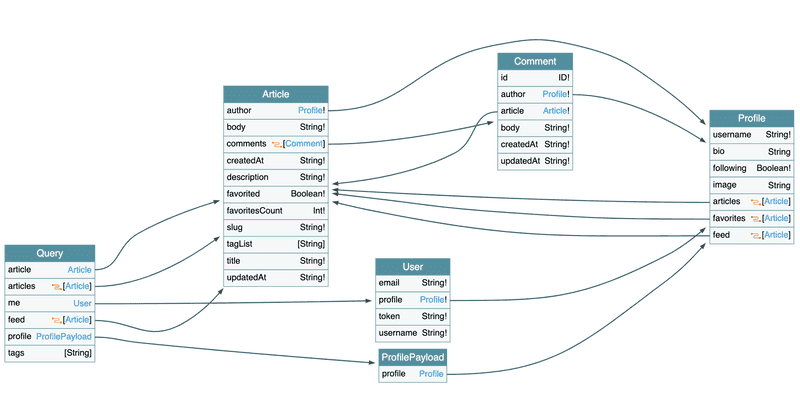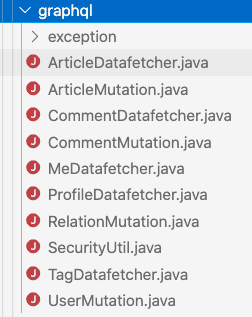Eisen's Blog
Real World 的 GraphQL 版本
June 16, 2021
Table of Contents
在很久之前的一篇 文章 介绍了我做的一个 RealWorld 的 SpringBoot + MyBatis 的实现。这个项目我也一直在维护,一方面是因为这是一个很好的 demo 项目,可以很好的体现一些设计思路 文章 也都说了不再重复。另一方面,我觉得也是一个新人练手不错的选择,可以让大家可以通过这个项目来入门。
最近在做 GraphQL 的调研和测试,我第一个想到的就是把这个项目添加上 GraphQL 的接口,一方面可以熟悉 GraphQL 的体系,另一方面也是个很好的机会去验证下是不是 REST 层是按照 六边形架构 或者说是 洋葱架构 那样子做成的是薄薄的一层,可以轻易的被替换掉。
对 api 层与 application 层做重构
当然,api 层和 application 层一点都不修改就能添加 GraphQL 是不可能的。主要是因为之前有不少的逻辑写在了 SpringBoot 的 Controller 里面了。那么这一部分的工作基本就是把大量放在 Controller 的代码挪动到 application 层。
确认 GraphQL 的 schema
然后就需要按照 REST api 提供一个对等的 GraphQL 的 schema 了。这里参考的是 https://github.com/thebergamo/realworld-graphql/blob/master/data/schema.graphql 。
Real World 似乎对 GraphQL 这部分的工作不太上心,这个东西已经挺久的了,但是官方并没有很好的支持。
不过它这个 schema 明显有两个问题:
- 少了
unfavoriteArticle的Mutation deleteArticle返回了错误的结果,明明应该是DeletionStatus
用 https://apis.guru/graphql-voyager/ 做展示基本就是这个样子:
schema 在 https://github.com/gothinkster/spring-boot-realworld-example-app/blob/master/src/main/resources/schema/schema.graphqls 可以看到。
可以看到 GraphQL 的 schema 是一张图,有点像是数据库的 ER Diagram。不过很显然,GraphQL 的关系肯定不是数据库级别的 CRUD 而是一个业务层级的关联图:
User的Profile下可以有很多Article的视图favoritesfeed;Article则有其自己的全量属性:authorcomments;Comment也有自己的articleauthor;
这部分让我想起来 DDD 书中提到的 Domain Model 对象之间的关联关系(第五章 A Model Expressed in Software)。和 REST 相比,通过 GraphQL 所组织的 schema 有更好的整体性和一致性。当然,这也有可能是它的缺点:它缺少了 REST 的那种随便搞个接口的灵活性。
增加 GraphQL 的代码
这里的实现采用了 Netflix DGS 这个框架,很符合 SpringBoot 的设计逻辑,并且最近也一直在密集的更新中。
从文件组织上看,每个 Entity 或者是 EntityList 可以组织一个 Datafetcher 提供给具体某一个 Query 下的特定 type 的查询。而针对某个 Entity 的 Mutation 可以放到一起?这部分不太确定,可能还是刚刚开始做,感受不是很明显。
对于 nested query 的处理
既然是一张图,那么查询就可以是一个树,比如可以有这么一个查询:
query {
me {
profile {
articles {
edges {
node {
comments {
edges {
node {
body
}
}
}
}
}
}
}
}
}获取当前用户的 articles 并且包含它的 comment 的 body。类似的问题在 Nested data fetchers 有做一些阐述。而我这个例子就是遇到了 https://netflix.github.io/dgs/advanced/context-passing/#no-showid-use-local-context 这部分阐述的情况,需要自己创建一个 Map 并放到 localContext 中做传递。具体的代码如下:
ArticleDatafetcher.java:
package io.spring.graphql;
...
@DgsComponent
public class ArticleDatafetcher {
...
@DgsData(parentType = PROFILE.TYPE_NAME, field = PROFILE.Articles)
public DataFetcherResult<ArticlesConnection> userArticles(
...
DgsDataFetchingEnvironment dfe) {
User current = SecurityUtil.getCurrentUser().orElse(null);
Profile profile = dfe.getSource();
CursorPager<ArticleData> articles;
...
graphql.relay.PageInfo pageInfo = buildArticlePageInfo(articles);
ArticlesConnection articlesConnection =
ArticlesConnection.newBuilder()
.pageInfo(pageInfo)
.edges(
articles.getData().stream()
.map(
a ->
ArticleEdge.newBuilder()
.cursor(a.getCursor().toString())
.node(buildArticleResult(a))
.build())
.collect(Collectors.toList()))
.build();
return DataFetcherResult.<ArticlesConnection>newResult()
.data(articlesConnection)
.localContext( // 这里将 slug : article 的 map 传递到下一个层级了
articles.getData().stream().collect(Collectors.toMap(ArticleData::getSlug, a -> a)))
.build();
}
...
}
CommentDatafetcher.java:
package io.spring.graphql;
...
@DgsComponent
public class CommentDatafetcher {
...
@DgsData(parentType = ARTICLE.TYPE_NAME, field = ARTICLE.Comments)
public DataFetcherResult<CommentsConnection> articleComments(
...
DgsDataFetchingEnvironment dfe) {
if (first == null && last == null) {
throw new IllegalArgumentException("first 和 last 必须只存在一个");
}
User current = SecurityUtil.getCurrentUser().orElse(null);
Article article = dfe.getSource();
Map<String, ArticleData> map = dfe.getLocalContext(); // 获取 map
ArticleData articleData = map.get(article.getSlug()); // 使用 slug 获取具体的 ArticleData
CursorPager<CommentData> comments;
...
graphql.relay.PageInfo pageInfo = buildCommentPageInfo(comments);
CommentsConnection result =
CommentsConnection.newBuilder()
.pageInfo(pageInfo)
.edges(
comments.getData().stream()
.map(
a ->
CommentEdge.newBuilder()
.cursor(a.getCursor().toString())
.node(buildCommentResult(a))
.build())
.collect(Collectors.toList()))
.build();
return DataFetcherResult.<CommentsConnection>newResult()
.data(result)
.localContext(
comments.getData().stream().collect(Collectors.toMap(CommentData::getId, c -> c))) // 这里同样传递了一个 id : comment 的 map 到下一个层级
.build();
}
...
}
这种传递 map 的方式也算是官方指定的最佳实践了吧,并且基本不可或缺。因为很多时候 Source 和实际从 Application 层传递的 DTO 的类型就是不一样的,可能缺了不少数据。
效果
只要 Application 层保证重用并且捋清楚了 DataFetcher 之间的数据传递关系,后面做起来感觉就一马平川了,毕竟这也不是一个什么很大很复杂的项目。
完成之后感觉这种网状关系的调用体验还是很好的,感觉对 API 的调用方来说,一旦熟悉了这种模式就可以更容易的组合各种比较复杂的视图,而不会像 REST 那样担心大量的手工数据组合。
开发过程中的一些小问题
- Intellij 对 GraphQL 本身的支持还不够好
- Dgs 是个比较新的框架,加上国内似乎很少有做类似东西的人,资料很少
- RealWorld 本身对 GraphQL 的推进也很慢,后续我应该会增加英文版本的 ReadME 介绍 GraphQL 这部分的工作,并且希望可以有前端做支持

